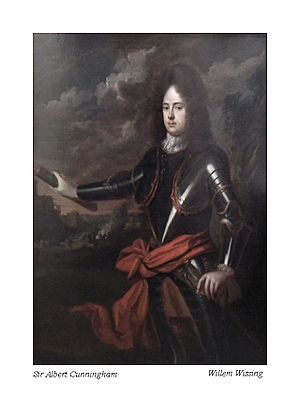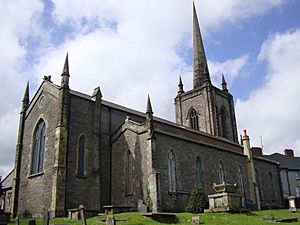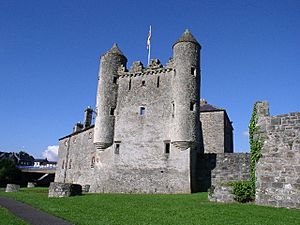6th (Inniskilling) Dragoons facts for kids
Quick facts for kids The Inniskillings (6th Dragoons) |
|
|---|---|
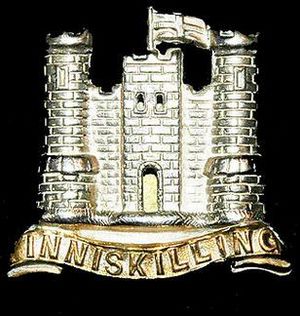
Badge of the Inniskilling Dragoons
|
|
| Active | 1689–1922 |
| Country | |
| Allegiance | British Empire |
| Branch | British Army |
| Type | Cavalry of the Line |
| Role | Heavy Cavalry |
| Size | 1 Regiment |
| Nickname(s) | The Skins The Skillingers |
| Motto(s) | Inniskilling |
| March | (Quick) Fare Ye Well Enniskillen. (Slow) The Inniskkilling Dragoons. |
| Commanders | |
| Notable commanders |
Field Marshal Viscount Allenby |
The 6th (Inniskilling) Dragoons was a famous cavalry regiment in the British Army. It was first formed in 1689. Back then, it was known as Sir Albert Cunningham's Regiment of Dragoons.
This regiment fought in many important battles. One of its most famous was the Battle of the Boyne in July 1690. In 1751, it became the 6th (Inniskilling) Regiment of Dragoons. The Inniskillings also showed great bravery in the Charge of the Union Brigade at the Battle of Waterloo. Later, they were part of the successful Charge of the Heavy Brigade at the Battle of Balaclava during the Crimean War.
By the time of the First World War, technology had changed warfare. Horses were no longer as useful on the battlefield. The British Army decided to reorganize its cavalry. Many famous regiments were combined or closed down. The Inniskillings was one of these. After serving for over 200 years, including in the First World War, it joined with the 5th (Princess Charlotte of Wales's) Dragoon Guards in 1922. They formed a new regiment called the 5th/6th Dragoons.
Contents
History of the Inniskillings
The Inniskillings have a long and interesting history, full of brave actions and important moments.
How the Regiment Started
In 1689, King James II, who had lost his throne, came to Ireland. He had help from France and wanted to take back his crown from William of Orange. During this time, the town of Enniskillen was being defended. The town's leader, Gustav Hamilton, created three regiments to fight for William of Orange.
One of these new groups was a cavalry unit called Dragoons. These were soldiers who rode horses but could also fight on foot. This unit started on June 20, 1689. It was named Cunningham's Dragoons after its first commanding officer, Sir Albert Cunningham. It was ranked as the 6th Dragoons. Later, it became known as the "Enniskillen Dragoons." This name came from Hamilton's headquarters at Enniskillen Castle. The name "Inniskilling" comes from an old Irish name for the town, meaning 'Island of Kathleen'.
Early Battles and Wars
After helping to end the Siege of Derry in 1689, the regiment continued fighting in the Williamite Wars. On June 19, they tried to find the enemy forces. The "Enniskilliners" found some enemy horse and foot soldiers near Belturbet.
They attacked the enemy in Belturbet. The Inniskillen horsemen surrounded the churchyard where the enemy was. Their foot soldiers took over nearby buildings. From these buildings, they fired at the enemy inside the churchyard. After two hours, the enemy surrendered. The Inniskillings captured nearly 300 prisoners and a lot of supplies. This included muskets, horses, and food.
In 1690, the regiment was numbered the 7th Dragoon Regiment. They fought bravely at the Battle of the Boyne in July 1690. In 1691, the regiment was renamed Echlin's Dragoons. It was also known as the Enniskillen Horse.
Later, in 1715, the regiment helped stop riots in Manchester. They also fought in the Battle of Sheriffmuir during the Jacobite rising. The regiment went to Flanders in 1742. They fought in several battles during the War of the Austrian Succession. These included the Battle of Dettingen in June 1743 and the Battle of Fontenoy in May 1745. In 1751, the regiment was officially renamed the 6th (Inniskilling) Regiment of Dragoons.
The regiment then fought in the Battle of Minden in August 1759. This was during the Seven Years' War.
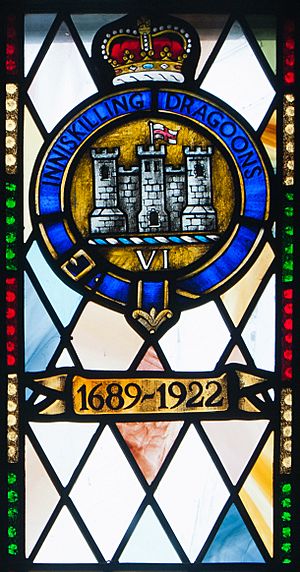
The Union Brigade's Charge at Waterloo
The Union Brigade was a group of three heavy cavalry regiments. One was English (the Royal Dragoons), one Scottish (The Scots Greys), and one Irish (the Inniskillings). This is why they were called the "Union" Brigade. At the Battle of Waterloo, the Inniskillings were led by Lieutenant-Colonel Joseph Muter.
The Union Cavalry Brigade was ordered to charge. The 6th/Inniskilling Dragoons rode through the lines of other British soldiers. The French soldiers were surprised to see British cavalry suddenly appear. When the cavalry hit them, the French soldiers were trying to form a line. They were thrown into confusion.
The French 45th Infantry Regiment carried a special flag called an "eagle." Sergeant Charles Ewart of the Scots Greys captured this eagle. The Royal Dragoons also captured an eagle from the French 105th Regiment. These were the only two eagles captured during the entire Waterloo campaign!
After their successful charge, the Union Brigade became disorganized. Many of the cavalrymen kept riding forward, even when they were told to stop. They rode between the French divisions, causing more confusion. The French infantry, expecting a much larger cavalry attack, eventually stopped and fell back.
The Heavy Brigade's Charge at Balaclava
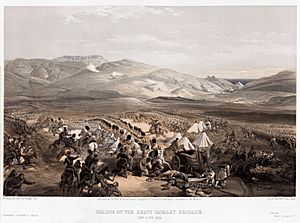
The regiment went to the Crimea in April 1854. Sadly, during the journey, their ship, the Europa, sank. The commanding officer and 17 men were lost. Lieutenant-Colonel Henry Dalrymple White then took command. He led the regiment into action at the Battle of Balaclava in October 1854.
The first line of attack included the Scots Greys and one group of Inniskillings. This was less than 250 horsemen. Their charge was not a fast gallop like the Light Brigade. Instead, it was more of a trot. Dragoons were larger men with heavier equipment. They moved steadily towards the large numbers of Russian cavalry.
Even at a slower speed, the impact of these heavy cavalrymen hitting the lighter Russian cavalry was powerful. A captain from the Inniskillings described the chaos: "Forward - dash - bang - clank, and there we were in the midst of such smoke, cheer, and clatter, as never before stunned a mortal's ear. it was glorious! Down, one by one, aye, two by two fell the thick skulled and over-numerous Cossacks... It was all push, wheel, frenzy, strike and down, down, down they went."
Colonel Paget of the Light Brigade called it "a mighty affair." He said that considering the challenges and the difference in numbers, it was a feat of arms that was "certainly never surpassed in the annals of cavalry warfare."
Late 19th Century and Boer War
In 1861, the regiment was renamed the 6th (Inniskilling) Dragoons. They helped respond to the Indian Rebellion in 1857. They also served during the Anglo-Zulu War in 1879.
After the Second Boer War started in October 1899, the regiment went to South Africa. They were part of General French's forces. One group helped relieve the Siege of Kimberley in February 1900. The regiment then joined the cavalry brigade that advanced on Pretoria, one of the Boer capitals. They fought in the battles of Diamond Hill and Belfast. The war ended in May 1902.
Early 20th Century and World War I
The regiment later went to India. In August 1914, they returned and landed in France in December 1914. They served on the Western Front during the First World War.
In 1921, the regiment was renamed The Inniskillings (6th Dragoons). In 1922, it combined with the 5th (Princess Charlotte of Wales's) Dragoon Guards. They formed a new regiment called the 5th/6th Dragoons.
Regimental Museum
The museum for the Inniskillings, along with the Royal Inniskilling Fusiliers, is located in Enniskillen Castle. It's a great place to learn more about their history.
The Regimental Chapel
The special chapel for the regiment is in St Macartin's Cathedral, Enniskillen.
Enniskillen Castle
Enniskillen Castle is very important to the Inniskilling Dragoons. The regiments formed in Enniskillen during the Williamite Wars are closely connected to the castle. The Inniskilling Dragoons were often based there. The regiment's badge even shows a picture of the castle.
Notable Dragoons
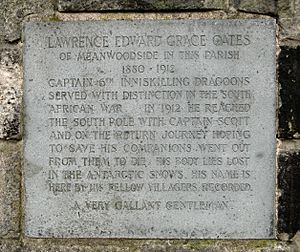
- Field Marshal Lord Edmund Henry Hynman Allenby: He served with the regiment from 1882 to 1900.
- Lawrence 'Titus' Oates: He was an officer in the regiment, famous for his role in the ill-fated Terra Nova Expedition to the South Pole.
Battle Honours
Battle honours are special awards given to regiments for their bravery in battles. Here are some of the Inniskillings' battle honours:
- Early Wars: Dettingen, Warburg, Willems, Waterloo, Balaklava, Sevastopol, South Africa 1899-1902
- The Great War: Somme 1916 '18, Morval, Cambrai 1917 '18, St. Quentin, Avre, Lys, Hazebrouck, Amiens, Hindenburg Line, St. Quentin Canal, Beaurevoir, Pursuit to Mons, France and Flanders 1914-18
Colonel-in-Chief
- 1897: Field Marshal HRH Arthur William Patrick Albert, 1st Duke of Connaught & Strathearn (died 1942)


